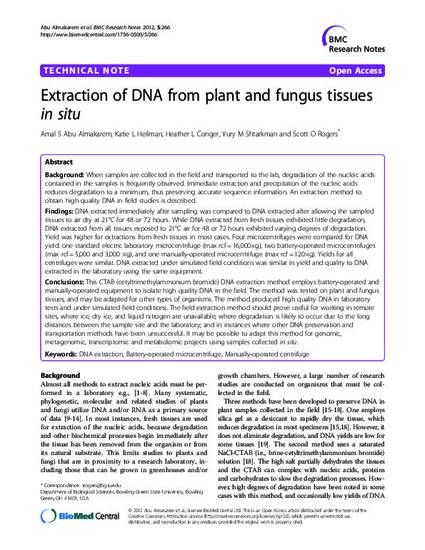
Background: When samples are collected in the field and transported to the lab, degradation of the nucleic acids contained in the samples is frequently observed. Immediate extraction and precipitation of the nucleic acids reduces degradation to a minimum, thus preserving accurate sequence information. An extraction method to obtain high quality DNA in field studies is described. Findings. DNA extracted immediately after sampling was compared to DNA extracted after allowing the sampled tissues to air dry at 21°C for 48 or 72 hours. While DNA extracted from fresh tissues exhibited little degradation, DNA extracted from all tissues exposed to 21°C air for 48 or 72 hours exhibited varying degrees of degradation. Yield was higher for extractions from fresh tissues in most cases. Four microcentrifuges were compared for DNA yield: one standard electric laboratory microcentrifuge (max rcf=16,000×g), two battery-operated microcentrifuges (max rcf=5,000 and 3,000 ×g), and one manually-operated microcentrifuge (max rcf=120×g). Yields for all centrifuges were similar. DNA extracted under simulated field conditions was similar in yield and quality to DNA extracted in the laboratory using the same equipment. Conclusions: This CTAB (cetyltrimethylammonium bromide) DNA extraction method employs battery-operated and manually-operated equipment to isolate high quality DNA in the field. The method was tested on plant and fungus tissues, and may be adapted for other types of organisms. The method produced high quality DNA in laboratory tests and under simulated field conditions. The field extraction method should prove useful for working in remote sites, where ice, dry ice, and liquid nitrogen are unavailable; where degradation is likely to occur due to the long distances between the sample site and the laboratory; and in instances where other DNA preservation and transportation methods have been unsuccessful. It may be possible to adapt this method for genomic, metagenomic, transcriptomic and metabolomic projects using samples collected in situ. © 2012 Abu Almakarem et al.; licensee BioMed Central Ltd.
Available at: http://works.bepress.com/scott_rogers/3/
